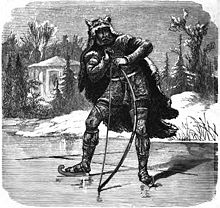From Wikipedia, the free encyclopedia
Mythological location
 Leaning on a bow, the god Ullr stands atop a frozen lake surrounded by evergreen trees and a building (1882) by
Friedrich Wilhelm Heine
.
Leaning on a bow, the god Ullr stands atop a frozen lake surrounded by evergreen trees and a building (1882) by
Friedrich Wilhelm Heine
.
In
Norse mythology
,
Ydalir
("
yew
-
dales
"
[1]
) is a location containing a dwelling owned by the god
Ullr
. Ydalir is solely attested in the
Poetic Edda
, compiled in the 13th century from earlier traditional sources. Scholarly theories have been proposed about the implications of the location.
Attestations
[
edit
]
Ydalir is solely attested in stanza 5 of the poem
Grimnismal
(collected in the
Poetic Edda
), where Odin (disguised as
Grimnir
) tells the young
Agnar
that Ullr owns a dwelling in Ydalir. The stanza reads (
Ydalir
is here translated as
Ydalir
):
- Ydalir it is called, where Ullr
- has himself a dwelling made.
- Alfheim
the gods
Frey
gave
- in days of yore for a tooth-gift.
[2]
Theories
[
edit
]
Discussing Ydalir,
Henry Adams Bellows
comments that "the wood of the yew-tree was used for bows in the North just as it was long afterwards for England."
[3]
Rudolf Simek
says that "this connexion of the god with the yew-tree, of whose wood bows were made (cf. ON
ybogi
'yew bow'), has led to Ullr being seen as a bow-god."
[4]
Andy Orchard comments that Ydalir is an "aptly named dwelling-place [for the]
archer
-god, Ull."
[1]
According to
Hilda Ellis Davidson
, while Valhalla "is well known because it plays so large a part in images of warfare and death," the significance of other halls in Norse mythology such as Ydalir, and the goddess
Freyja
's afterlife location
Folkvangr
has been lost.
[5]
Udale
, located in
Cromarty
,
Scotland
, is first recorded in 1578, and is thought to derive from Old Norse
y-dalr
. Robert Bevan-Jones proposes a connection between veneration of Ullr and Ydalir among the settling pagan Norse in Scotland and their bestowment of the name
ydalr
to the location.
[6]
In popular culture
[
edit
]
Ydalir was probably the inspiration for the name of a bow in the 1996 Super Famicom game
Fire Emblem: Genealogy of the Holy War
. A legendary bow wielded by the crusader Ullr (named after the Norse God) is called
Ichiibaru
(
イチイバル
)
, with "
Ichii
" the Japanese term for "Yew", and "baru" perhaps a loose Japanese syllabification of the English word "
valley
." The same term was used in the 2012 anime
Symphogear
. In 2013, "Ichaival" was added to an
English Wikipedia
list, but incorrectly presented as a Norse term for a bow of Odin, rather than a Japanese phrase translating Ydalir's meaning of "Yew Dales". This confusion resulted in the inclusion of "Ichaival" elsewhere as a bow of Odin originating in Norse mythology, notably in the 2014 video game
Smite
. The erroneous term was briefly removed in 2015 but quickly restored; it was removed more finally from the English Wikipedia article in 2018.
[7]
Notes
[
edit
]
References
[
edit
]
|
|---|
|
| |
|---|
| Locations
| | Underworld
| |
|---|
| Rivers
| |
|---|
| Other locations
| |
|---|
|
|---|
| Events
| |
|---|
| Sources
| |
|---|
| Society
| | Religious practice
| |
|---|
| Festivals and holy periods
| |
|---|
| Other
| |
|---|
|
|---|
| See also
| |
|---|